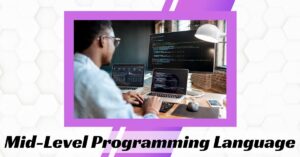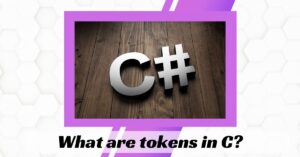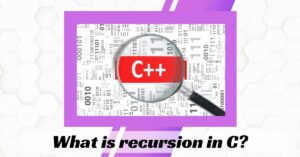Table of Contents
ToggleIntroduction
At Bell Labs, Dennis Ritchie developed the C programming language between 1971 and 1973. C is a mid-level structured-oriented and general-purpose programming language which is considered one of the oldest and most popular programming languages. It has a wide range of applications, from language compilers and operating systems to assemblers, network drivers, text editors, print spoolers, modern applications, language interpreters, databases and utilities.
C Programming language is often perceived as complex but it is still an invaluable tool for enhancing your programming capabilities. Depending on experience level and individual proficiency with coding, questions related to C can be divided into two categories:
Freshers
Experienced coders.
This article “C Programming Questions” aims to provide a comprehensive resource for those seeking to prepare for C programming questions for interviews, both for fresher and more experienced levels. To begin, we will focus on the types of questions typically asked of those with limited experience in the field. We have gathered a list of the most commonly asked C Programming questions, as well as detailed answers that can help you showcase your knowledge and understanding of the language. Whether you are an entry level programmer or an experienced professional, these questions and their answers should be helpful in preparing you for success in your next C programming interview. Let’s see in this C programming question, what can the interviewer ask about?
1. Why is C called a mid-level programming language?

In this C programming question, Interviewer may asked you about- C is a versatile programming language which is why it is commonly referred to as a middle-level language – it has the ability to incorporate both low and high-level features. This means it can be used to write programs that are converted into assembly code as well as being machine-independent, providing the programmer with the flexibility of pointer arithmetic (low-level) and ease of use (high-level). C is often utilized for writing operating systems and menu-driven consumer billing systems due to its impressive combination of features.
Let’s delve a little deeper and uncover a few more C programming questions.
2. What are basic data types supported in the C Programming Language?
In this C programming question, the interviewer may inquire about the each variable which has an associated data type that dictates how much memory it requires, the range of values it can store, and the operations that can be performed on it. Data types are divided into four main categories: integer, character, floating-point (or real), and double-precision floating-point. In C data types are broadly classified into 4 categories:
Primitive data types:
Primitive data types can be further classified into two main categories: integer and floating. Integer data types are used to represent a whole number, while floating data types are used to represent numbers with decimal points.
Void Types:
Void data types, which fall under the umbrella of primitive data types, provide no result to their caller and have no associated value. In other words, a void data type is essentially used to signify that nothing should be returned from a function – it is a placeholder for an empty value.
User Defined data types:
These data types are defined by the user to make the program more easily understandable. By assigning meaningful names to values, data variables, and operations within a program, it can be read like a sentence instead of a jumble of numbers and symbols.
Derived data types:
There are several kinds of data types that can be derived from primitive or built-in data types. These derived data types can be classified into two broad categories – composite and abstract. Composite data types are composed of multiple components, such as arrays, records, and objects.
Let’s take a plunge into the depths of C programming questions and reveal a more mysteries.
3. What are tokens in C?

Tokens are the smallest individual pieces of code that a compiler can recognize and interpret within a program. In the C programming questions languages, there are several types of tokens, including identifiers, operators, punctuation symbols, and keywords.
Keywords:
These keywords are essential for programming in C, as they provide the foundation for more complex functions and operations.
Identifiers:
Identifiers are user-defined names that can be composed of an unlimited number of either digits or letters, as long as the first character is a letter or an underscore (_). It is important to note that identifiers must not match any of the reserved keywords within the C programming language.
Constants:
Constants are particularly useful when coding in languages such as C and C++, where values often need to remain consistent and unchanging in order to ensure the desired function of the program.
Strings:
Strings in C are an array of characters that terminate with a special character known as the null character (‘’). This null character indicates the end of the string, and is essential for the string to be properly identified and interpreted by the compiler.
Special Symbols:
C programming language utilizes a variety of special symbols that have specific meanings and cannot be used for any other purpose. These symbols include the pound sign (#), curly brackets ({}), parentheses (()), comma (,), asterisk (*), semicolon (;) and square brackets ([]).
Operators:
The C Programming language utilizes a range of symbols known as operators. These operators are divided into three distinct categories: Unary, Binary, and Ternary. Depending on the type of operator used, different actions can be triggered when they are applied.
Let’s explore language C further by asking more C programming questions.
4. What is the difference between malloc() and calloc() in the C programming language?
The calloc() and malloc() library functions are used to allocate dynamic memory in the C Programming language. Dynamic memory is essentially memory that is allocated during the runtime of the program from the heap segment – meaning it can be used without needing to be declared ahead of time. In order for access to these library functions, you must include the “stdlib.h” header file, which facilitates dynamic memory allocation within the program.
| Parameter | Malloc() | Calloc() |
| Definition | This function provides the capabil ity to create a single contiguous block of memory, with a specified size that cannot be altered. It is especially useful for allocating large amounts of memory at once, as it avoids having to create multiple smaller blocks. Memory allocated in this way can be used to store and manipulate data such as arrays of numbers or characters. | This function is extremely useful in programming, as it allows a single variable to be assigned multiple blocks of memory. This means that a program can store more complex data types such as arrays or linked lists, which would otherwise require many individual variables to store. By using this function, programs can become more efficient and streamlined, saving both time and memory. |
| Number of arguments | It only takes one argument to make a difference; this single assertion can be the deciding factor in any debate or discussion. It could be the one thing that helps convince others of your point of view, swaying them to your opinion. This concept is why it’s important to make sure that any argument you present is well-thought out and convincing, as it could be the deciding point in the whole conversation. | This function requires two arguments to be passed in order to execute properly, each argument providing specific information that is essential for the function to work correctly. |
| Speed | The malloc() function is known to be faster than the calloc() function when it comes to memory allocation. This is because the malloc() function only requires a single pass through the memory, whereas calloc() requires two passes in order to properly initialize each element of the allocated memory block. Furthermore, malloc() does not require the additional step of setting all the bytes in the allocated block to 0, as calloc() does. This makes malloc() more effective and efficient when dealing with larger blocks of memory, as it can save time by eliminating one or more steps in the process. | Although calloc() and malloc() are both C library functions used to request memory allocations, calloc() is typically slower than malloc(). This is because calloc()’s primary purpose is to initialize the allocated memory by setting all bytes in allocated memory blocks to zero, while malloc() only allocates the requested amount of memory. While this extra step of allocating and setting the memory to 0 may be necessary in some cases, it does slow down the process compared to malloc(), which simply allocates requested memory. |
| Efficiency | When making decisions, time efficiency must be considered. | This method takes a long time to finish tasks, making it hard to meet deadlines. |
| Usage | Memory allocation is the act of assigning a portion of a computer system’s memory to store data or instructions. | Contiguous memory allocation is a data storage technique in which related elements are stored consecutively in memory. |
Let’s go deeper and ask more C programming questions.
5. What do you mean by dangling pointers and how are dangling pointers different from memory leaks in C programming?
What knowledge do you have about C programming questions? This question from the interviewer can provide insight into a dangling pointer in C Programming is a pointer that points to a memory block that has been deallocated, meaning the variable it was pointing to has been deleted and yet the pointer still points to the same memory location. This can lead to a memory leak, which occurs when memory is allocated with the help of library functions malloc() or calloc(), but then forgotten about and not freed with the free() library function. As a result, an undefined amount of RAM is taken up by the program, making it unavailable for other applications which can cause our program to crash.
Now, let us investigate further and uncover additional C programming questions.
6. What is recursion in C?

Recursion is the process of making a function call itself directly or indirectly in order to solve a particular problem. This process involves breaking down the original problem into smaller subproblems and then calling a copy of the same function to solve them. This method of solving problems helps to reduce code complexity and length, as well as make it easier to comprehend. The recursive function relies on a Last In First Out (LIFO) structure like a stack, where each recursive call requires additional space in the stack memory. This way, multiple calls can be stored until they are ready to be executed one by one in reverse order.
7. What is the difference between the local and global variables in C?
Local variables are declared within the confines of a block or function, and cannot be accessed outside of this context. Conversely, global variables are declared outside of a block or function, making them available throughout the program, regardless of their location in the code. This allows global variables to be used for values that need to be shared between different parts of the codebase, such as configuration settings or user data.
| Local Variables | Global Variables |
| Hidden away like a secret, tucked deep within a block or a function – that’s where you’ll find the declaration. | Variables that exist beyond the boundaries of a block or a function, existing in a realm of their own, waiting to be discovered and leveraged. |
| Unless otherwise specified, variables are like forgotten suitcases, randomly filled with a jumble of worthless odds and ends. | The world-wide value was set to nothingness by default. |
| Once the block or function has reached its conclusion, the brief existence of local variables is extinguished. Like a candle in a gust of wind, their purpose fulfilled and lives ended in an instant. | The flame of the global variable burns fiercely until the program is unleashed, bringing its contents to life. |
| The programmer is the master of their own code, able to designate where variables should rest – whether it be in the depths of the stack or beyond. | The compiler strategically places the global variable in its own special corner of memory, ensuring that it’s always nearby and ready to be accessed. |
| In order to tap into the local variables of other functions, parameter passing is a must. It’s like unlocking a secret door to another realm, offering a glimpse behind the scenes and providing access to places that would otherwise remain hidden. | No handing off of information is necessary – they’re there for all to see, throughout the entirety of the program. It’s a global access to the parameters, open to any who need it. |
8. What are pointers and their uses?

The interviewer may pose the following C programming questions: Pointers are like the GPS for your computer, pinpointing exact locations in memory. With a pointer, you can direct your program to a specific variable or memory location. This allows for efficient use of resources, helping you save both memory space and time! And that’s not all – pointers can also be used to refer to other pointer functions are-
- To pass arguments by reference
- For accessing array elements
- To return multiple values
- Dynamic memory allocation
- To implement data structures
- To do system-level programming where memory addresses are useful
9. What is the difference between type casting and type conversion?
You can noticed several difference between type casting and type conversion in this C programming questions blog-
| Type Casting | Type Conversion |
| A programmer can transform raw information into a usable asset with the aid of a casting operator, turning one data type into another. It’s like alchemy, turning lead into gold! | A compiler works its magic, transforming one data type into another with a few swift strokes. |
| This remarkable tool can seamlessly bridge the gap between two seemingly incompatible data types, creating a harmonious union of ideas. | When it comes to type conversion, it’s all about compatibility – only data types that are perfectly matched can be transformed into one another. |
| To convert a data type to another type, a cast operator is required for type casting. | Casting operators are not necessary for type conversion. |
| The efficiency and reliability of type casting is unmatched, providing a sure-fire way to ensure the smooth flow of data. | Type conversion may be seen as a more convenient route to achieve the same result, but type casting is undeniably the superior choice; it offers quicker, more reliable results and ensures accuracy for any given task. |
| As the programmer sits at their desk, huddled over lines of code, type casting takes place – a crucial part of the program design. With a few clicks and keystrokes, the programmer is able to carefully craft their masterpiece and bring it to life. | The compiler works hard to transform your code into something executable – and one of the tasks it handles is type conversion. This process happens during compile time, allowing your program to run smoothly. |
Syntax: destination_data_type = (target_data_type) variable_to_be_converted; | Syntax: int a = 20; float b; b = a; // a = 20.0000 |
10. What are header files and their uses?
Ready to test your C programming mettle? See how you fare with this C programming questions: C language has numerous libraries with predefined functions to simplify programming. Header files, which must have a “.h” extension, contain function definitions, data type definitions, and macros. These can be imported into a program using the preprocessor directive “#include”. There are two types of header files: user-defined and pre-existing. For example, if code needs to take input from the user and print output, “#include<stdio.h>” must be included in the program. This header file contains functions such as scanf() and printf() for taking input from the user and printing content.
Conclusion
In conclusion, we have seen that C programming is a versatile and powerful language for developing programs. It provides powerful data types and operators, as well as a wide variety of functions for managing memory and files. Additionally, the syntax can be simple to learn or quite complex depending on the user’s needs. With the right tools and techniques, it can easily help create robust applications with efficient code execution while also providing portability across different platforms. All in all, C programming is an excellent choice for anyone looking to write their own software projects.
Frequently Asked Questions
Why should I learn C programming (questions with answers)?
1. Low level language: C is a low-level language, which means that it gives more control over memory management and the hardware of your system than other high-level languages.
2. Popularity: C is one of the most widely used programming languages in the world today and is used by developers from various fields due to its popularity.
3. Versatility: Learning C gives you access to a wide range of different platforms where this language can be used, ranging from embedded systems to mobile applications or even video game development!
4. Efficient Code: When using higher level languages like Java or Python, compiling code into bytecode often leads to longer execution times compared with running natively compiled code written in lower level languages like Assembly or C.
5. Powerful Libraries & Open Source Tools : Making use of powerful libraries such as GLib from GNOME allows developers writing applications in this language have access not only powerful IO capabilities but also support for modern IPC mechanisms (like DBus!)
Why indiabix C programming quizzes?
Indiabix C programming quizzes are an excellent way to learn and strengthen your knowledge of the subject. The questions in these quizzes range from basic concepts such as data types, variables and control statements, to more advanced topics such as pointers, dynamic memory allocation, linked lists and file I/O. Not only are these questions essential in understanding the fundamentals of programming language but they also test your ability to write efficient code. By taking these quizzes regularly you can stay abreast with new trends and implementations thus increasing your efficiency as a developer.
How many learn C programming programiz accounts can I have?
Unfortunately there is no definitive answer to this question as it largely depends upon the terms and conditions of the particular platform you are using. Generally speaking, most websites that offer learning resources allow you to have only one account per person, however this may vary from site-to-site. In the case of Programiz specifically, they do not provide an explicit number regarding how many accounts can be created by a single user, but they do encourage users to contact them with any specific queries or concerns. We would recommend contacting Programiz directly through their contact page or email address for further advice on this matter.
What is an FAQ list?
An FAQ list, or frequently asked questions list, is an organized collection of questions and answers related to a particular topic. It can be used by people who want to quickly find information on a given subject without having to search through lengthy documents or perform online research. Commonly seen on websites and customer service portals, FAQ lists are designed to give information in an easy-to-understand format that is more convenient than searching for detailed answers elsewhere.
When should we use pointers in a C program?
- Obtain the address of a variable.
- To achieve pass by reference in C, pointers can be used to enable different functions to access and modify their local variables.
- To avoid copying entire structures in full.
- Implement linked data structures, such as linked lists and binary trees.













